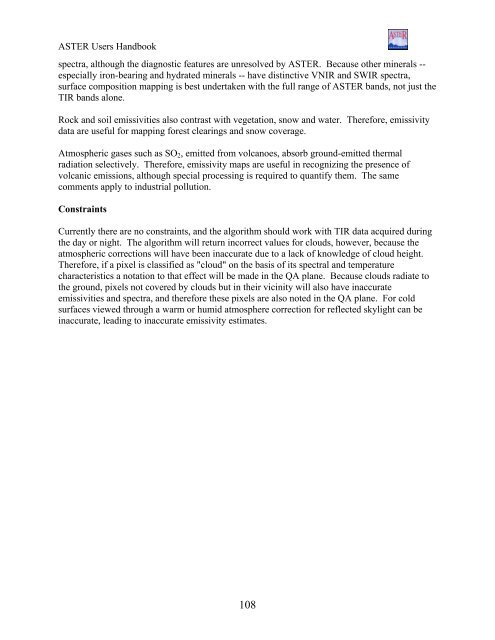Create successful ePaper yourself
Turn your PDF publications into a flip-book with our unique Google optimized e-Paper software.
<strong>ASTER</strong> Users Handbookspectra, although the diagnostic features are unresolved by <strong>ASTER</strong>. Because other minerals --especially iron-bearing and hydrated minerals -- have distinctive VNIR and SWIR spectra,surface composition mapping is best undertaken with the full range of <strong>ASTER</strong> bands, not just theTIR bands alone.Rock and soil emissivities also contrast with vegetation, snow and water. Therefore, emissivitydata are useful for mapping forest clearings and snow coverage.Atmospheric gases such as SO 2 , emitted from volcanoes, absorb ground-emitted thermalradiation selectively. Therefore, emissivity maps are useful in recognizing the presence ofvolcanic emissions, although special processing is required to quantify them. The samecomments apply to industrial pollution.ConstraintsCurrently there are no constraints, and the algorithm should work with TIR data acquired duringthe day or night. The algorithm will return incorrect values for clouds, however, because theatmospheric corrections will have been inaccurate due to a lack of knowledge of cloud height.Therefore, if a pixel is classified as "cloud" on the basis of its spectral and temperaturecharacteristics a notation to that effect will be made in the QA plane. Because clouds radiate tothe ground, pixels not covered by clouds but in their vicinity will also have inaccurateemissivities and spectra, and therefore these pixels are also noted in the QA plane. For coldsurfaces viewed through a warm or humid atmosphere correction for reflected skylight can beinaccurate, leading to inaccurate emissivity estimates.108















